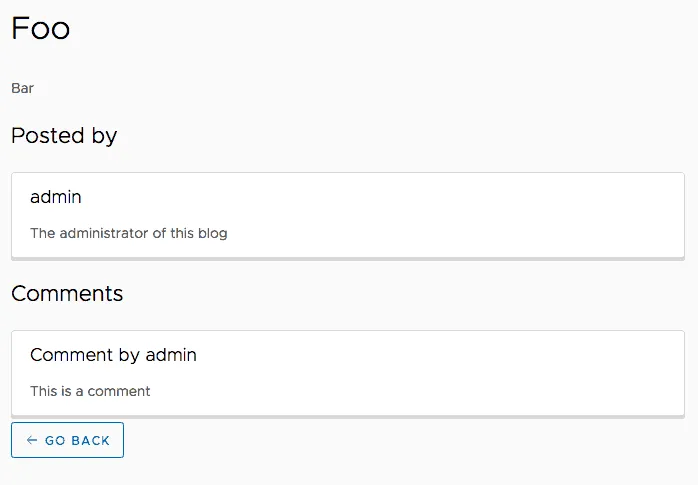Last time, we wrote a GraphQL API using Spring boot and the graphql-java library. Today, we’ll write a simple frontend application using Angular. As mentioned in my previous article, there are few JavaScript libraries out there that we can use. Facebook, which is also behind the idea of GraphQL, wrote a library called Relay. Additionally, the group behind Meteor wrote their own library called Apollo. In this example I’ll be using Apollo as the GraphQL library.

Getting started
To get started, I’ll create a new Angular application using Angular CLI, using the following command:
ng new graphql-blog-app
After the project is generated, you need to install a few dependencies:
npm install apollo-angular apollo-angular-link-http apollo-client apollo-cache-inmemory graphql-tag graphql --save
Now that your project is ready, you can create your own ApolloConfigModule by using the following command:
ng g module apollo-config
In this module, you need to import both ApolloModule and HttpLinkModule and you have to set up Apollo by adding the following constructor:
@NgModule({
imports: [
CommonModule,
ApolloModule,
HttpLinkModule
],
declarations: []
})
export class ApolloConfigModule {
constructor(apollo: Apollo, httpLink: HttpLink) {
apollo.create({ link: httpLink.create({uri: 'http://localhost:4200/graphql' }), cache: new InMemoryCache() });
}
}
The final step is to add ApolloConfigModule to the imports of your AppModule. Next to this module, you also have to include the HttpClientModule, because this module is required by the HttpLinkModule:
@NgModule({
declarations: [
AppComponent
],
imports: [
BrowserModule,
HttpClientModule, // Add this
ApolloConfigModule // Add this
],
providers: [],
bootstrap: [AppComponent]
})
export class AppModule { }
Writing your own queries
Last time, we wrote two queries:
- One to obtain a list of all articles with their title and some basic information about who posted the article.
- Another one to obtain more information about a single article, including the comments of the article.
In this tutorial, we’ll be using both queries. To do this, I’ll create a new TypeScript file where I can export all queries as constants:
export const AllArticlesQuery = gql`query AllArticles {
articles {
id
title
author {
id
username
}
}
}`;
export const ArticleDetailQuery = gql`query Article($articleId: Int!) {
article(id: $articleId) {
id
title
text
author {
id
username
bio
}
comments {
id
text
author {
id
username
}
}
}
}`;
The gql function makes these string literals into GraphQL queries that can be used with Apollo. Make sure you don’t forget to import it:
import gql from 'graphql-tag';
Making the calls
Now that we have our queries, it’s time to use them to call the GraphQL API. But before we do this, I’m going to write the model interfaces for our responses. First of all we have the interfaces that match the query response themself:
export interface AllArticlesQueryResponse {
articles: Article[];
}
export interface ArticleDetailQueryResponse {
article: Article;
}
Next to that, we also have the Article, Comment and Profile interfaces to implement:
export interface Article {
id: number;
title: string;
author: Profile;
text?: string;
comments?: Comment[];
}
export interface Profile {
id: number;
username: string;
bio?: string;
}
export interface Comment {
id: number;
text: string;
author: Profile;
}
Now that we have our model interfaces, we can actually make the call by writing our own service. So let’s generate a service using Angular CLI:
ng g service article/article
In our service, inject the Apollo class into the constructor:
constructor(private apollo: Apollo) { }
This service will contain two functions, a findAll() function and a findOne() function. The findAll() function is the easiest one since it doesn’t require parameters:
findAll(): Observable<AllArticlesQueryResponse> {
return this.apollo
.query<AllArticlesQueryResponse>({ query: AllArticlesQuery })
.map(result => result.data);
}
By using the apollo.query() function, we can invoke GraphQL using the given query. The query in this case is AllArticlesQuery, which I imported from the TypeScript file I wrote earlier.
The findOne() function wil be similar, but will pass an additional parameter, being the articleId. You don’t need to add the dollar sign ($) to the parameter name, unlike in our query:
findOne(id: number): Observable<ArticleDetailQueryResponse> {
return this.apollo
.query<ArticleDetailQueryResponse>({ query: ArticleDetailQuery, variables: { articleId: id } })
.map(result => result.data);
}
Using the data
With our service complete, we can basically use it like any other service we would write. For example, I wrote an ArticleOverviewComponent that will show the title of each blog article in a list of cards:
<h1>Blog articles</h1>
<div class="row">
<div class="col-sm-4" *ngFor="let article of articles">
<app-article-card [article]="article"></app-article-card>
</div>
</div>
In the component we can inject the service and use the findAll() function in the ngOnInit() function:
ngOnInit() {
this.service.findAll().subscribe(result => this.articles = result.articles);
}
Similar to the article overview component, I wrote an ArticleDetailComponent with the following template:
<h1>{{article?.title}}</h1>
<p>{{article?.text}}</p>
<h3>Posted by</h3>
<app-profile-card [profile]="article?.author"></app-profile-card>
<h3>Comments</h3>
<app-comments-card [comments]="article?.comments"></app-comments-card>
<a class="btn btn-outline" [routerLink]="['/articles']"><clr-icon shape="arrow left"></clr-icon> Go back</a>

Like the other component, we can retrieve the article using the service in our ngOnInit() function:
ngOnInit() {
this.route.paramMap
.map((params: ParamMap) => params.get('id'))
.map(articleId => parseInt(articleId, 10))
.switchMap(articleId => this.service.findOne(articleId))
.subscribe(response => this.article = response.article);
}
In this function I’m using the ActivatedRoute to retrieve the route parameters to obtain the ID of the given article. Then I use switchMap() to switch it by another observable, in this case the one from our service. Finally, I can subscribe to it to retrieve the result.

If you’re intersted in the full code, you can find it on GitHub.
